Once more, the bulk of the past year’s testing focused on maintenance products, safety essentials, and do-it-yourself substitutes for higher priced marine gear. Part of this was because COVID-19 derailed some of our more ambitious projects (don’t worry they are still on the slate). Part of this was because we continue to try to buck the trend toward high-priced, budget-busting marine-grade gear that is out of reach of many sailors.
Flexdel ROPE Dip
Anchorages are strewn with rocks, coral, or even an old engine blocks. For these places the best rode leader is chain. However, with “diving” anchor designs and high-strength cordage creeping into sailing, we explored the viability of no-chain anchor or mooring (now the norm in environmentally sensitive areas). But what about chafe? One solution we’ve explored in the past is rope coatings.
In previous PS tests, RP25 by Spinlock and Maxijacket by Yale Cordage had proven to reduce wear 5-10 times, depending on the application. The product we looked at in 2020 was Rope Dip by Flexdel, a company known for its industrial marine products.
Our technical editor, Drew Frye has tested both of these in the field in his home waters of the Chesapeake, where all-rode anchoring has served him well.
Similar to Maxijacket, Rope Dip raises the bar, delivering exceptional wear resistance and good economy. If you want a little added wear resistance on a fiber rode, this is the ticket. Coated eye-splices will outlast the line in many cases. It will also work well on lines and snubbers where they pass through chocks. RP25 and Maxijacket come ready-to-use, while Rope Dip must be diluted with water, further increasing economy.
Bottom Line: This was our best Choice and Best Buy in a high-resistance coating.
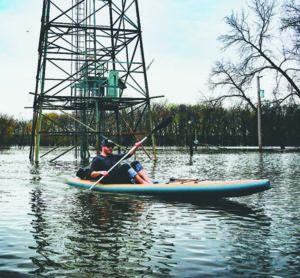
Paddle North Karve
We’ve dipped in and out of the category of kayaks and paddle boards and don’t pretend to have tested every boat under the sun. However, our testers are keen paddlers, so they do follow this category closely. One inflatable kayak that appeared on our radar in 2020 was the Paddle North Karve. Like the Airis, this inflatable features a cut-out cockpit area with a separate floor, providing a place to put a few things, a lower center of gravity, and enough drainage to prevent a wet bottom, at least in sheltered waters.
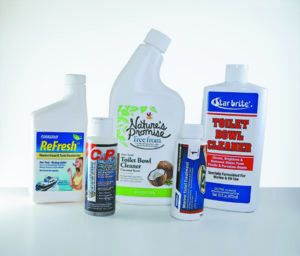
Several of the tests we carried out over the past year were aimed at smaller boat owners who either by choice or budget are bound to the keep it simple sailor (KISS) philosophy.
Star-brite Toilet bowl cleaner
The majority of grocery store toilet bowl cleaners contain bactericides that inhibit bacterial activity in the holding tank and contribute to bad smells. These same chemicals attack the head pump and hose materials, shortening their lives and increasing permeation. There are a handful of eco-friendly and septic-friendly products that work, but you’ll need to read the MSDS sheets and check them against out list of damaging ingredients to be certain.
We strongly urge cleaning in moderation. Anything that contains enough surfactant to make a real difference will logically also strip grease from the head pump. A better strategy is to spray the bowl regularly with a dilution of either one of the suggested head treatments or Raritan CP. Apply elbow grease when needed, and a little CLR for stubborn lime deposits.
In this way the cleaning action is concentrated only where it is needed. When you do need a cleaner, avoid bleach, quaternary amines, and solvents, and use one of our recommended products in moderation. A prolonged soak in a mild acid (CLR, Sew Clean, or other PS tested descaler) to remove calcium deposits from the joker valve and hose is okay, but otherwise avoid long soaks
Although there are many similar products, Star brite Toilet Bowl Cleaner with citric acid and surfactants stood out in our comparison of “green” cleaners.
Bottom line: Toilet cleaning products can be overkill. Star-brite cleaner is both ecofriendly and effective.
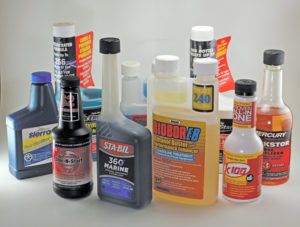
Biobor EB For corrosion
Ever since we adopted improved fuel management methods, we’ve enjoyed a decade of no carburetor maintenance—not on the twin 9.9 hp engines that ran our catamaran, not on the dinghy kicker, and not on our trimaran. Not on any of our chainsaw or blower motors. Given the quarterly ritual we’d enjoyed before, it’s been wonderful.
After our initial studies of corrosion in August and December of 2012, we’ve kept an eagle eye on gasoline and diesel additives, researching and testing their effectiveness on reducing corrosion and gumming. Why the fanatical focus on corrosion? Because all of our research and all of our testing (see PS November 2015) suggest that the primary cause of gasoline instability, including gum formation, is metal ions resulting from corrosion of metals. We have also seen that corrosion products are the most common cause of clogging, and that these deposits are harder to remove because solvent carb cleaners can’t dissolve them.
New products have entered the market and old products have been reformulated. Frankly, we expected that all of them were going to wow us this time, with astounding ability to protect fuel systems. But alas, that was not to be.
BioborEB from longtime fuel additive contender Hammonds Chemical was a favorite in our 2012 testing. It once again it provided superior corrosion protection. The treated sample compared with the no-water control. Don’t confuse with Biobor JF, which is a diesel biocide.
Bottom line: This our Best Choice and is what we have been using for the last 10 years.
Our test paddle was on a nasty, rainy day, and the sharply pointed bow and V-shaped entry of the Karve showed its value, cutting through the chop better than the blunt bow of the Airis and pounding less than the flat-bottomed Glide. We wish it had thigh strap braces, like the Airis. It has a strap you can tuck your feet under, but nothing to provide good solid side bracing.
Bottom line: This is a true contender for cruisers looking for a kayak.
iEvac Smoke/Fire Hood
After 34 people died of smoke inhalation in a tragic explosion on a California dive boat in September 2019, our testers began looking for compact fire hoods that cruisers could use to escape their own boat in the event of a fire. In our November 2019 issue, testers found several good contenders, but settled on the Elmeridge IEVAC fire hood as their favorite. Currently, this is the only mask certified to the ASTM E2952 standard for single-use escape masks. Using a clear hood, the hood from Elmeridge has two elastic bands instead of one, and twin cartridges for longer time to escape.
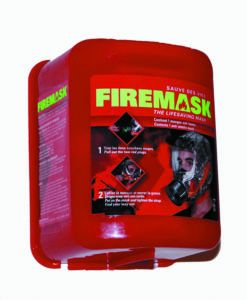
Bottom line: The IEVAC provided better fit and easier breathing than others in our test, but required slightly more time to don.
Selden Furlex 304 Furler
After our comprehensive furler comparison in August of 2009, during which we evaluated several furlers that were pre-installed on other boats, we finally got around to installing one on our test boat First Light a Bristol 35.5. The owner of First Light Tim Cole, also our publisher, spent several hours documenting his experience installing the Furlex 304 furler for the October 2019 issue of Practical Sailor.
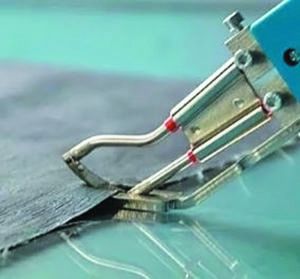
It’s easy to underestimate what goes into a headsail furler until you see all the bits and pieces laid out and ready for assembly. The Furlex system came as a complete package right down to the replacement forestay, nuts and bolts for the turning stanchion blocks, a Sta-Lok terminal, furling line, even a pre-feeder. The unit arrives in one large square box, a flat box with the eight-millimeter forestay, and a sizeable packing tube for the headfoil sections and full-length plastic “distance” tubes inside them.
To specify the system that’s right for your boat you need to know the displacement, the length of the existing forestay and the pin size. We triangulated these parameters using Selden’s excellent user manual, which contains a very good worksheet to precisely establish where you’ll cut the provided 50-foot forestay.
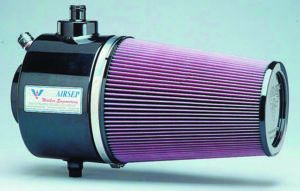
installed)
So can you do it yourself? The answer is. . . quite a bit, but certainly not all. A true do-it-yourself installation requires a good level of experience, a solid team and a set-up that includes a safe, expedient way to get to the masthead to detach the old furler and re-attach the new one.
The need to work aloft is often the biggest roadblock. You’ll be using your headsail halyard as a temporary forestay, so you’ll need to haul the new furler up the masthead on a spinnaker halyard while the mainsail halyard is pressed into service for the bosuns chair. If you don’t have a spinnaker halyard then you’ll need to figure out a way to go aloft.
Bottom line: You’ll need some help, but the results are worth the effort.
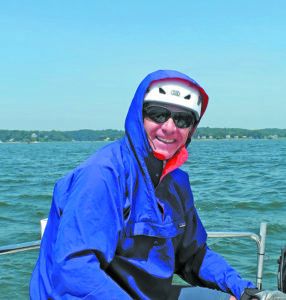
While not for the average sailor, there are an increasing number of performance and small boat sailors who are wearing helmets. Primarily known for mountaineering and industrial climbing gear, sailors know Kong for the robust Tango tether clip used on most safety tethers (See “Safety Tethers Under Scrutiny,” PS March, 2018). In addition to climbing gear, Kong also makes anchor swivels, mooring hooks, and snap shackles.
At only 8 ounces, Kong’s new helmet is 62 percent lighter than any competitor, and only 35 percent heavier than a ball cap with a bump insert. You barely know it’s there. The combination of efficient insulation, massive ventilation channels, and the reflective white color also made it the coolest of the helmets we tested.
Designed as a mountaineering helmet (EN 12492), it meets impact requirements 2-4 times greater than those required of water sports helmets. Foam construction ensures it floats. Because it is also a mountaineering helmet, requiring four times greater top impact protection, the Kong helmet sits about ½-inch higher on the head than water sports helmets. We didn’t find this noticeable sailing, except when wearing it under a hood. We’ve been wearing the Leaf sailing, kayaking, and climbing, barely aware that it is there. Yes, it’s a helmet, but it’s as cool to wear as a ball cap and barely heavier.
Bottom line: Kong’s model is simply more comfortable than any other we tested. One size fits most. Price is $129.
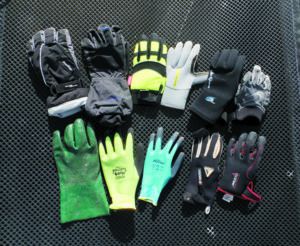
Musto Winter Glove
In March of 2020 we compared a wide range of gloves that readers had recommended over the years. While there were warmer and more water resistant gloves in the test, the Musto gloves had check marks in all the other areas that mattered to performance sailors. They were relatively warm for the “performance” category, they had a good fit at the fingertips, promoting good line handling. A thin layer of grip material on the palm and fingers wore through within a few days, but this proved to be superficial and the underlying layer proved quite tough. We used them hard as our main glove through the winter, and plan to use them for many more seasons.
Bottom line: Recommended and Best Choice for active sailors.
Walker System
We relied on interviews with service pros and sailors in the field to identify air filters for cruisers. The first thing to address with the Walker system is the price. For about $500 (plus installation), the Walker system includes a coalescing crankcase vent filter that catches lube oil mist and returns it to the crankcase. The fumes are then sucked into the intake. Additionally, all of the fresh air is filtered.
In addition to separating the lube oil from the vent gases, the Airsep provides filtration of the vent stream and pressure regulation for the crankcase. A simple catch can system will continue to vent when a hot engine is shut down, but the Airsep has a pressure-regulating valve system, something like the PVC valve on a car, that reduces venting after shut down, eliminating engine room odors.
Bottom line: They probably have some benefit in terms of engine life, but just as importantly, they keep the engine room cleaner and the boat smelling fresher. For those who care not about price, this was our Best Choice.
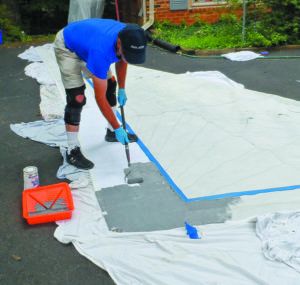
Can paint provide viable UV protection for sails, maybe even replacing the usual sun protection strip on furling genoas? North and Doyle have been offering paint as a UV protection option for several years, though it is a specialty item, typically reserved for light air sails and mega-yachts. We had some success from less expensive brands, and one brand of paint developed specifically for such a purpose quickly rose to the top.
The lone sail-specific paint in this test, Marine Shield lived up to our high expectations. Its performance in the flogging test was flawless. The coverage and appearance of this paint were very good, with very little light passing through.
The only observable difference between Marine Shield and the other paints we tested was higher gloss. Marine Shield is also slipperier, which should give it some advantage in furling and storage. The New Zealand product is not yet distributed in the U.S., though the company is working to line up a distributor.
This is not a project we’d recommend for the average cruising sailor. For most people, Sunbrella and Weather Max remain the gold standard for heavy duty UV covers for sails that live on a furler. The cloth outlasts the stitching that holds them, UV blocking is superior, and they provide physical protection and support. No other material offers this combination. But this protection is relatively heavy and expensive to replace.
UV Dacron and Tedlar films offer a lighter weight option. Self-adhesive fabric seems like a great DIY replacement option, but durability isn’t much better than paint, and sail shape can be affected when self-adhesive tapes are installed over large areas. This is particularly problematic with laminate sails and sails that are seriously creased and wrinkled.
We see a lot to like in using paint for old sails. It demonstrates good UV protection and surprising durability. The relatively low price make them a valid DIY option for the sailor who would rather save his beans for a new jib in five years than invest in a sewn cover for an old dog that is stretched out of shape.
We also see value of using paint on laminate sails that live part time on a furler, so long as you recognize that the UV protection is not perfect and that the sail should be put away when you are away from the boat for a few days.
Bottom line: Our Best Choice for a sail paint. Hopefully, it will become more widely available to DIY sailors. The true test will be durability over the next few years, but so far our experience with paint has been good.
K&N Airsep
For those who aren’t inclined to pony up $500 for an air cleaner, the K&N Airsep offers a more affordable alternative. The most common supplier of aftermarket intake filters for sailboats, K&N can spec a clamp-on filter and housing that will fit your old engine. These sturdy fiber filter elements won’t disintegrate like a foam filter.
Bottom line: Best Choice for someone looking for a quality fabric filter.
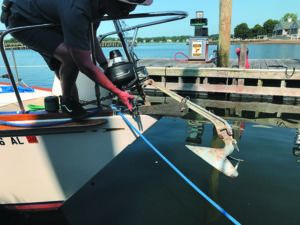
Engle HSGM Hot Knife
As we reviewed years of tool reports from past issues, we realized we’d never really taken a very close look at a valuable sail repair tool—the hot knife. This 90-watt unit is the gold standard in hot knives, we’ve seen this model in most sail and canvas lofts. Perfect temperature control, better balance than a soldering iron, and it will outlive any DIY. Replacement blades and blades for cutting foam etc. are available. The cutting foot is particularly handy, allowing you to cut out windows and work around other fabric. Available online, it costs about $190.
Bottom line: Sometimes rebranded and sold under another name, this hot-knife is our Best Choice.
KONG, www.kongusa.com
SELDEN,www.seldenmast.com
IEVAC, www.elmeridgeprotection.com
FLEXDEL, www.flexdel.com
K&N, www.knfilters.com
WALKER, www.walkerfiltration.com
PADDLE NORTH, www.paddlenorth.com
ENGLE HSGM, www.hsgmusa.com
MUSTO, www.sika.com
MARINE SHIELD,www.marineshield.co.nz
STAR BRITE, www.star-brite.com
BIOBOR, www.biobor.com
































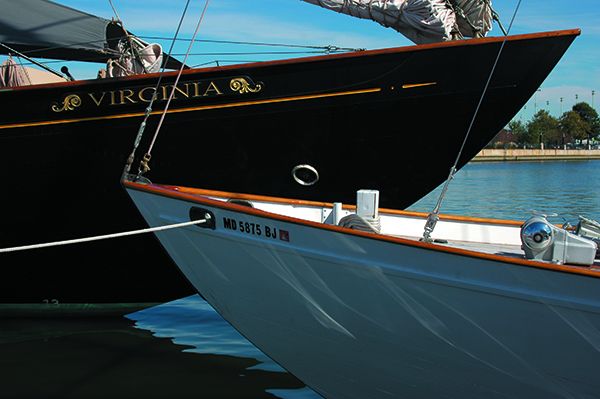




fyi, pics for furler and air filters are exchanged